The Discovery of the New UHP Eclogite from the East Kunlun, Northwestern China, and Its Tectonic Significance
Abstract
:1. Introduction
2. Geological Background
2.1. Regional Geology and Tectonics
2.2. Local Geology
3. Analytical Methods
3.1. Mineral Chemistry
3.2. Whole-Rock Major and Trace Elements
3.3. Zircon U-Pb Dating, Trace Element Analyses
3.4. Raman Spectrum
4. Results
4.1. Sample Petrography
4.2. Mineral Chemistry and Assemblage
4.2.1. East Gouli Eclogite (E-Gouli-08)
4.2.2. Gazhima Eclogite (LMG-06)
4.3. Whole-Rock Compositions
4.3.1. East Gouli Eclogite (E-Gouli)
4.3.2. Gazhima Eclogite (LMG)
4.4. Zircon Geochronology and REE Patterns
4.4.1. East Gouli Eclogite (E-Gouli-08)
4.4.2. Gazhima Eclogite (LMG-06)
4.5. Metamorphic P-T Calculations
5. Discussion
5.1. Identification of UHP Metamorphism and P-T Path
5.2. Metamorphic Geochronology
5.3. Tectonic Implication
6. Conclusions
Supplementary Materials
Author Contributions
Funding
Data Availability Statement
Acknowledgments
Conflicts of Interest
References
- Frisch, W.; Meschede, M.; Blakey, R. Contractional theory, continental drift and plate tectonics. In Plate Tectonics: Continental Drift and Mountain Building; Frisch, W., Meschede, M., Blakey, R.C., Eds.; Springer: Berlin/Heidelberg, Germany, 2011; pp. 1–13. [Google Scholar]
- Zheng, Y.; Chen, Y.; Chen, R.; Dai, L. Tectonic evolution of convergent plate margins and its geological effects. Sci. China Earth Sci. 2022, 65, 1247–1276. [Google Scholar] [CrossRef]
- Zheng, Y.-F. Subduction zone geochemistry. Geosci. Front. 2019, 10, 1223–1254. [Google Scholar] [CrossRef]
- Bingen, B.; Davis, W.J.; Austrheim, H.k. Zircon U-Pb geochronology in the Bergen arc eclogites and their Proterozoic protoliths, and implications for the pre-Scandian evolution of the Caledonides in western Norway. GSA Bull. 2001, 113, 640–649. [Google Scholar] [CrossRef]
- Klonowska, I.; Janák, M.; Majka, J.; Froitzheim, N.; Kośmińska, K. Eclogite and garnet pyroxenite from Stor Jougdan, Seve Nappe Complex, Sweden: Implications for UHP metamorphism of allochthons in the Scandinavian Caledonides. J. Metamorph. Geol. 2016, 34, 103–119. [Google Scholar] [CrossRef]
- Schorn, S.; Diener, J.F.A. Details of the gabbro-to-eclogite transition determined from microtextures and calculated chemical potential relationships. J. Metamorph. Geol. 2017, 35, 55–75. [Google Scholar] [CrossRef]
- Chopin, C. Coesite and pure pyrope in high-grade blueschists of the Western Alps: A first record and some consequences. Contrib. Mineral. Petrol. 1984, 86, 107–118. [Google Scholar] [CrossRef]
- Sobolev, N.V.; Shatsky, V.S. Diamond inclusions in garnets from metamorphic rocks: A new environment for diamond formation. Nature 1990, 343, 742–746. [Google Scholar] [CrossRef]
- Burov, E.; Francois, T.; Agard, P.; Le Pourhiet, L.; Meyer, B.; Tirel, C.; Lebedev, S.; Yamato, P.; Brun, J.-P. Rheological and geodynamic controls on the mechanisms of subduction and HP/UHP exhumation of crustal rocks during continental collision: Insights from numerical models. Tectonophysics 2014, 631, 212–250. [Google Scholar] [CrossRef]
- Zhang, L.; Zhang, G. Ultrahigh Pressure Metamorphism. In Encyclopedia of Geology (Second Edition); Zhang, L., Zhang, G., Eds.; Academic Press: Oxford, UK, 2021; pp. 553–560. [Google Scholar]
- Zhang, L.; Ellis, D.J.; Jiang, W. Ultrahigh-pressure metamorphism in western Tianshan, China: Part I. Evidence from inclusions of coesite pseudomorphs in garnet and from quartz exsolution lamellae in omphacite in eclogites. Am. Mineral. 2002, 87, 853–860. [Google Scholar] [CrossRef]
- Burov, E.; Jolivet, L.; Le Pourhiet, L.; Poliakov, A. A thermomechanical model of exhumation of high pressure (HP) and ultra-high pressure (UHP) metamorphic rocks in Alpine-type collision belts. Tectonophysics 2001, 342, 113–136. [Google Scholar] [CrossRef]
- Burtman, V.S.; Molnar, P.; Burtman, V.S.; Molnar, P. Geological and Geophysical Evidence for Deep Subduction of Continental Crust Beneath the Pamir. In Geological and Geophysical Evidence for Deep Subduction of Continental Crust Beneath the Pamir; Geological Society of America: Boulder, CO, USA, 1993; Volume 281. [Google Scholar]
- Yamato, P.; Agard, P.; Burov, E.; Le Pourhiet, L.; Jolivet, L.; Tiberi, C. Burial and exhumation in a subduction wedge: Mutual constraints from thermomechanical modeling and natural P-T-t data (Schistes Lustrés, western Alps). J. Geophys. Res. Solid Earth 2007, 112, 1–28. [Google Scholar] [CrossRef]
- Hacker, B.R.; Gerya, T.V. Paradigms, new and old, for ultrahigh-pressure tectonism. Tectonophysics 2013, 603, 79–88. [Google Scholar] [CrossRef]
- Angiboust, S.; Agard, P.; Jolivet, L.; Beyssac, O. The Zermatt-Saas ophiolite: The largest (60-km wide) and deepest (c. 70–80 km) continuous slice of oceanic lithosphere detached from a subduction zone? Terra Nova 2009, 21, 171–180. [Google Scholar] [CrossRef]
- Zhang, Q.; Gao, X.; Chen, R.; Zheng, Y. Metamorphic evolution of the East Tethys tectonic domain and its tectonic implications. Sci. China Earth Sci. 2023, 66, 2686–2711. [Google Scholar] [CrossRef]
- Zhao, G.; Wang, Y.; Huang, B.; Dong, Y.; Li, S.; Zhang, G.; Yu, S. Geological reconstructions of the East Asian blocks: From the breakup of Rodinia to the assembly of Pangea. Earth-Sci. Rev. 2018, 186, 262–286. [Google Scholar] [CrossRef]
- Song, S.G.; Niu, Y.L.; Li, S.; Cong, Z.; Zhang, L.F. Continental orogenesis from ocean subduction, continent collision/subduction, to orogen collapse, and orogen recycling: The example of the North Qaidam UHPM belt, NW China. Earth-Sci. Rev. 2014, 129, 59–84. [Google Scholar] [CrossRef]
- Song, S.G.; Niu, Y.L.; Zhang, G.B.; Zhang, L.F. Two epochs of eclogite metamorphism link ‘cold’ oceanic subduction and ‘hot’ continental subduction, the North Qaidam UHP belt, NW China. Geol. Soc. Lond. 2018, 474, 1–15. [Google Scholar] [CrossRef]
- Yu, S.; Zhang, J.; Li, H.; Hou, K.; Mattinson, C.G.; Gong, J. Geochemistry, zircon U-Pb geochronology and Lu-Hf isotopic composition of eclogites and their host gneisses in the Dulan area, North Qaidam UHP terrane: New evidence for deep continental subduction. Gondwana Res. 2013, 23, 901–919. [Google Scholar] [CrossRef]
- Zhang, G.; Han, L.; Zhang, L.; Song, S.; Liu, S. The transition from oceanic to continental subduction and collision: A case study of the North Qaidam ultrahigh-pressure metamorphic belt, northern Tibetan Plateau. J. Asian Earth Sci. 2023, 242, 105488. [Google Scholar] [CrossRef]
- Zhang, G.B.; Song, S.G.; Zhang, L.F.; Niu, Y.L. The subducted oceanic crust within continental-type UHP metamorphic belt in the North Qaidam, NW China: Evidence from petrology, geochemistry and geochronology. Lithos 2008, 104, 99–118. [Google Scholar] [CrossRef]
- Bi, H.; Whitney, D.L.; Song, S.; Zhou, X. HP–UHP eclogites in the East Kunlun Orogen, China: P–T evidence for asymmetric suturing of the Proto-Tethys Ocean. Gondwana Res. 2022, 104, 199–214. [Google Scholar] [CrossRef]
- Bi, H.Z.; Song, S.G.; Yang, L.M.; Allen, M.B. UHP metamorphism recorded by coesite-bearing metapelite in the East Kunlun Orogen (NW China). Geol. Mag. 2020, 157, 160–172. [Google Scholar] [CrossRef]
- Meng, F.; Zhang, J.; Cui, M. Discovery of Early Paleozoic eclogite from the East Kunlun, Western China and its tectonic significance. Gondwana Res. 2013, 23, 825–836. [Google Scholar] [CrossRef]
- Qi, S.S.; Song, S.G.; Shi, L.C.; Cai, H.J.; Hu, J.C. Discovery and its geological significance of Early Paleozoic eclogite in Xiarihamu-Suhaitu area, western part of the East Kunlun. Acta Petrol. Sin. 2014, 30, 3345–3356, (In Chinese with English abstract). [Google Scholar]
- Qi, X.P.; Fan, X.G.; Yang, J.; Cui, J.T.; Wang, B.Y.; Fan, Y.Z. The discovery of Early Paleozoic eclogite in the upper reaches of Langmuri in eastern East Kunlun Mountains and its significance. Geol. Bull. China 2016, 35, 1771–1783, (In Chinese with English abstract). [Google Scholar]
- Xiong, L.; Zhang, G.; Song, S.; Liu, S.; Feng, D.; Chang, F. Eclogite in the East Kunlun Orogen, northwestern China: A record of the Neoproterozoic breakup of Rodinia and early Paleozoic continental subduction. GSA Bull. 2023, 136, 1413–1430. [Google Scholar] [CrossRef]
- Zhou, W.; Chang, F.; Huang, B.; Xia, B.; Fu, D.; Chi Fru, E.; Li, H.; Lü, X.; Mao, C. Oceanic subduction to continental collision in the NE Proto-Tethys revealed by early Paleozoic eclogites with high-temperature granulite-facies overprinting in the East Kunlun orogenic belt, northern Tibet. GSA Bull. 2023, 136, 619–636. [Google Scholar] [CrossRef]
- Chang, F.; Zhang, G.; Xiong, L.; Liu, S.; Wang, S.; Liu, Y. Metabasites from the Central East Kunlun Orogenic Belt Inform a New Suture Model for Subduction and Collision in the Early Paleozoic Proto-Tethys Ocean. Minerals 2024, 14, 449. [Google Scholar] [CrossRef]
- Mo, X.X.; Luo, Z.H.; Deng, J.F.; Yu, X.H.; Liu, C.D.; Chen, H.W.; Liu, H.Y. Granitoids and Crustal Crowth in the East Kunlun Orogenic Belt. Geol. J. China Univ. 2007, 13, 403–414, (In Chinese with English Abstract). [Google Scholar]
- Fu, L.; Bagas, L.; Wei, J.; Chen, Y.; Chen, J.; Zhao, X.; Zhao, Z.; Li, A.; Zhang, W. Growth of early Paleozoic continental crust linked to the Proto-Tethys subduction and continental collision in the East Kunlun Orogen, northern Tibetan Plateau. GSA Bull. 2022, 135, 1709–1733. [Google Scholar] [CrossRef]
- Zhang, Y.; Pan, T.; Zhang, A.; He, S.; Qian, Y.; Bai, Y. Spatial Relationship between Eclogite and Copper-Nickel Mineralization in East Kunlun, China. Minerals 2023, 13, 330. [Google Scholar] [CrossRef]
- Huang, H.; Niu, Y.; Nowell, G.; Zhao, Z.; Yu, X.; Zhu, D.-C.; Mo, X.; Ding, S. Geochemical constraints on the petrogenesis of granitoids in the East Kunlun Orogenic belt, northern Tibetan Plateau: Implications for continental crust growth through syn-collisional felsic magmatism. Chem. Geol. 2014, 370, 1–18. [Google Scholar] [CrossRef]
- Zhou, B.; Dong, Y.; Zhang, F.; Yang, Z.; Sun, S.; He, D. Geochemistry and zircon U-Pb geochronology of granitoids in the East Kunlun Orogenic Belt, northern Tibetan Plateau: Origin and tectonic implications. J. Asian Earth Sci. 2016, 130, 265–281. [Google Scholar] [CrossRef]
- Zhao, X.; Fu, L.-b.; Santosh, M.; Wei, J.-h.; Chen, J.-j. The growth and evolution of continental crust contributed by multiple sources in the East Kunlun Orogen during Early Paleozoic. Earth-Sci. Rev. 2022, 233, 104190. [Google Scholar] [CrossRef]
- Dong, Y.; He, D.; Sun, S.; Liu, X.; Zhou, X.; Zhang, F.; Yang, Z.; Cheng, B.; Zhao, G.; Li, J. Subduction and accretionary tectonics of the East Kunlun orogen, western segment of the Central China Orogenic System. Earth-Sci. Rev. 2018, 186, 231–261. [Google Scholar] [CrossRef]
- Chen, N.-s.; Li, X.-y.; Wang, X.-y.; Chen, Q.; Wang, Q.-y.; Wan, Y.-s. Zircon SHRIMP U-Pb age of Neoproterozoic metagranite in the North Kunlun unit on the southern margin of the Qaidam block in China. Geol. Bull. China 2006, 25, 1311–1314. [Google Scholar]
- Lu, S.; Li, H.; Wang, H.; Chen, Z.; Zheng, J.; Xiang, Z. Detrital zircon population of Proterozoic meta- sedimentary strata in the Qinling-Qilian-Kunlun Orogen. Acta Petrol. Sin. 2009, 25, 2195–2208, (In Chinese with English abstract). [Google Scholar]
- Zhang, J.X.; Meng, F.C.; Wan, Y.S.; Yang, J.S.; Dong, G.A. Early Paleozoic tectono-thermal event of the Jinshuikou Group on the southern margin of Qaidam: Zircon U-Pb SHRIMP age evidence. Geol. Bull. China 2003, 22, 397–404, (In Chinese with English abstract). [Google Scholar] [CrossRef]
- Tang, H.; Zhang, H.F.; Zhang, M.J.; Zou, H.; Zhang, J. Neoproterozoic and early Paleozoic metamorphism recorded in gneisses from the East Kunlun Orogenic belt. Precambrian Res. 2022, 375, 106650. [Google Scholar] [CrossRef]
- Song, S.G.; Bi, H.Z.; Qi, S.S.; Yang, L.M.; Allen, M.B.; Niu, Y.L.; Su, L.; Li, W.F. HP-UHP Metamorphic Belt in the East Kunlun Orogen: Final Closure of the Proto-Tethys Ocean and Formation of the Pan-North-China Continent. J. Petrol. 2018, 59, 2043–2060. [Google Scholar] [CrossRef]
- Li, X.; Zhang, L.; Wei, C.; Slabunov, A.I.; Bader, T. Quartz and orthopyroxene exsolution lamellae in clinopyroxene and the metamorphic P–T path of Belomorian eclogites. J. Metamorph. Geol. 2018, 36, 1–22. [Google Scholar] [CrossRef]
- Wiedenbeck, M.; Allé, P.; Corfu, F.; Griffin, W.L.; Meier, M.; Oberli, F.; Quadt, A.V.; Roddick, J.C.; Spiegel, W. Three Natural Zircon Standards for U-Th-Pb, Lu-Hf, Trace Element and Ree Analyses. Geostand. Geoanalytical Res. 1995, 19, 1–23. [Google Scholar] [CrossRef]
- Vermeesch, P. IsoplotR: A free and open toolbox for geochronology. Geosci. Front. 2018, 9, 1479–1493. [Google Scholar] [CrossRef]
- Morimoto, N. Nomenclature of pyroxenes. Mineral. Petrol. 1988, 39, 55–76. [Google Scholar] [CrossRef]
- Smith, J.V. Feldspar Minerals: In Three Volumes. 2. Chemical and Textural Properties; Springer: Berlin/Heidelberg, Germany, 1974. [Google Scholar]
- Bas, M.J.L.; Maitre, R.W.L.; Streckeisen, A.; Zanettin, B.; IUGS Subcommission on the Systematics of Igneous Rocks. A Chemical Classification of Volcanic Rocks Based on the Total Alkali-Silica Diagram. J. Petrol. 1986, 27, 745–750. [Google Scholar] [CrossRef]
- Irvine, T.N.; Baragar, W.R.A. A Guide to the Chemical Classification of the Common Volcanic Rocks. Can. J. Earth Sci. 1971, 8, 523–548. [Google Scholar] [CrossRef]
- Pearce, J.A. Immobile Element Fingerprinting of Ophiolites. Elements 2014, 10, 101–108. [Google Scholar] [CrossRef]
- Shervais, J.W. Ti-V plots and the petrogenesis of modern and ophiolitic lavas. Earth Planet. Sci. Lett. 1982, 59, 101–118. [Google Scholar] [CrossRef]
- Sun, S.S.; McDonough, W.F. Chemical and Isotopic Systematic of Oceanic Basalt: Implications for the Mantal Composition and Processes; Special Publications; Geological Society: London, UK, 1989; Volume 42, pp. 313–345. [Google Scholar]
- Corfu, F.; Hanchar, J.M.; Hoskin, P.W.O.; Kinny, P. Atlas of Zircon Textures. Rev. Mineral. Geochem. 2003, 53, 469–500. [Google Scholar] [CrossRef]
- Hoskin, P.W.O.; Ireland, T.R. Rare earth element chemistry of zircon and its use as a provenance indicator. Geology 2000, 28, 627–630. [Google Scholar] [CrossRef]
- Rubatto, D. Zircon: The Metamorphic Mineral. Rev. Mineral. Geochem. 2017, 83, 261–295. [Google Scholar] [CrossRef]
- Holland, T.J.B.; Powell, R. An improved and extended internally consistent thermodynamic dataset for phases of petrological interest, involving a new equation of state for solids. J. Metamorph. Geol. 2011, 29, 333–383. [Google Scholar] [CrossRef]
- Powell, R.; Holland, T.; Worley, B. Calculating phase diagrams involving solid solutions via non-linear equations, with examples using THERMOCALC. J. Metamorph. Geol. 1998, 16, 577–588. [Google Scholar] [CrossRef]
- Green, E.C.R.; White, R.W.; Diener, J.F.A.; Powell, R.; Holland, T.J.B.; Palin, R.M. Activity–composition relations for the calculation of partial melting equilibria in metabasic rocks. J. Metamorph. Geol. 2016, 34, 845–869. [Google Scholar] [CrossRef]
- White, R.W.; Powell, R.; Holland, T.J.B.; Johnson, T.E.; Green, E.C.R. New mineral activity–composition relations for thermodynamic calculations in metapelitic systems. J. Metamorph. Geol. 2014, 32, 261–286. [Google Scholar] [CrossRef]
- White; Powell; Holland; Worley. The effect of TiO2 and Fe2O3 on metapelitic assemblages at greenschist and amphibolite facies conditions: Mineral equilibria calculations in the system K2O–FeO–MgO–Al2O3–SiO2–H2O–TiO2–Fe2O3. J. Metamorph. Geol. 2000, 18, 497–511. [Google Scholar] [CrossRef]
- Holland, T.; Powell, R. Activity–composition relations for phases in petrological calculations: An asymmetric multicomponent formulation. Contrib. Mineral. Petrol. 2003, 145, 492–501. [Google Scholar] [CrossRef]
- Tian, Z.L.; Wei, C.J. Metamorphism of ultrahigh-pressure eclogites from the Kebuerte Valley, South Tianshan, NW China: Phase equilibria and P–T path. J. Metamorph. Geol. 2013, 31, 281–300. [Google Scholar] [CrossRef]
- Wei, C.J.; Li, Y.J.; Yu, Y.; Zhang, J.S. Phase equilibria and metamorphic evolution of glaucophane-bearing UHP eclogites from the Western Dabieshan Terrane, Central China. J. Metamorph. Geol. 2010, 28, 647–666. [Google Scholar] [CrossRef]
- Tsai, C.-H.; Liou, J.G. Eclogite-facies relics and inferred ultrahigh-pressure metamorphism in the North Dabie Complex, central-eastern China. Am. Mineral. 2000, 85, 1–8. [Google Scholar] [CrossRef]
- Zhu, Y.; Ogasawara, Y. Phlogopite and Coesite Exsolution from Super-Silicic Clinopyroxene. Int. Geol. Rev. 2002, 44, 831–836. [Google Scholar] [CrossRef]
- Zhang, G.; Wang, J.; Webb, A.A.G.; Zhang, L.; Liu, S.; Fu, B.; Wu, C.; Wang, S. The protoliths of central Himalayan eclogites. GSA Bull. 2021, 134, 1949–1966. [Google Scholar] [CrossRef]
- Wang, H.; Wu, Y.-B.; Gao, S.; Liu, X.-C.; Liu, Q.; Qin, Z.-W.; Xie, S.-W.; Zhou, L.; Yang, S.-H. Continental origin of eclogites in the North Qinling terrane and its tectonic implications. Precambrian Res. 2013, 230, 13–30. [Google Scholar] [CrossRef]
- Brown, M. Duality of thermal regimes is the distinctive characteristic of plate tectonics since the Neoarchean. Geology 2006, 34, 961–964. [Google Scholar] [CrossRef]
- Zhang, Z.; Ding, H.; Dong, X.; Tian, Z.; Du, J. Metamorphism and tectonic mechanisms of subduction zones. Acta Petrol. Sin. 2021, 37, 3377–3398, (in Chinese with English abstract). [Google Scholar] [CrossRef]
- Pearce, J.A.; Norry, M.J. Petrogenetic implications of Ti, Zr, Y, and Nb variations in volcanic rocks. Contrib. Mineral. Petrol. 1979, 69, 33–47. [Google Scholar] [CrossRef]
- Pearce, J.A. Trace element characteristics of lavas from destructive plate boundaries. In Andesites; John Wiley and Sons: Hoboken, NJ, USA, 1982; pp. 528–548. [Google Scholar]
- Wood, D.A. The application of a ThHfTa diagram to problems of tectonomagmatic classification and to establishing the nature of crustal contamination of basaltic lavas of the British Tertiary Volcanic Province. Earth Planet. Sci. Lett. 1980, 50, 11–30. [Google Scholar] [CrossRef]
- Meschede, M. A method of discriminating between different types of mid-ocean ridge basalts and continental tholeiites with the Nb-Zr-bY diagram. Chem. Geol. 1986, 56, 207–218. [Google Scholar] [CrossRef]
- Zhang, C.; van Roermund, H.; Zhang, L.; Spiers, C. A polyphase metamorphic evolution for the Xitieshan paragneiss of the north Qaidam UHP metamorphic belt, western China: In-situ EMP monazite- and U–Pb zircon SHRIMP dating. Lithos 2012, 136–139, 27–45. [Google Scholar] [CrossRef]
- Zhang, C.; Zhang, L.F.; Roermund, H.V.; Song, S.G.; Zhang, G.B. Petrology and SHRIMP U–Pb dating of Xitieshan eclogite, North Qaidam UHP metamorphic belt, NW China. J. Asian Earth Sci. 2011, 42, 752–767. [Google Scholar] [CrossRef]
- Zhang, G.; Niu, Y.; Song, S.; Zhang, L.; Tian, Z.; Christy, A.G.; Han, L. Trace element behavior and P–T–t evolution during partial melting of exhumed eclogite in the North Qaidam UHPM belt (NW China): Implications for adakite genesis. Lithos 2015, 226, 65–80. [Google Scholar] [CrossRef]
- Zhou, G.; Zhang, J.; Li, Y.; Lu, Z.; Mao, X.; Teng, X. Metamorphic Evolution and Tectonic Implications of the Granulitized Eclogites from the Luliangshan Terrane in the North Qaidam Ultrahigh Pressure Metamorphic Belt, NW China: New Constraints from Phase Equilibrium Modeling. J. Earth Sci. 2019, 30, 585–602. [Google Scholar] [CrossRef]
- Zhou, G.; Zhang, J.; Yu, S.; Li, Y.; Lu, Z.; Mao, X.; Teng, X. Metamorphic evolution of eclogites and associated metapelites from the Yuka terrane in the North Qaidam ultrahigh pressure metamorphic belt, NW China: Constraints from phase equilibrium modeling. J. Asian Earth Sci. 2019, 173, 161–175. [Google Scholar] [CrossRef]
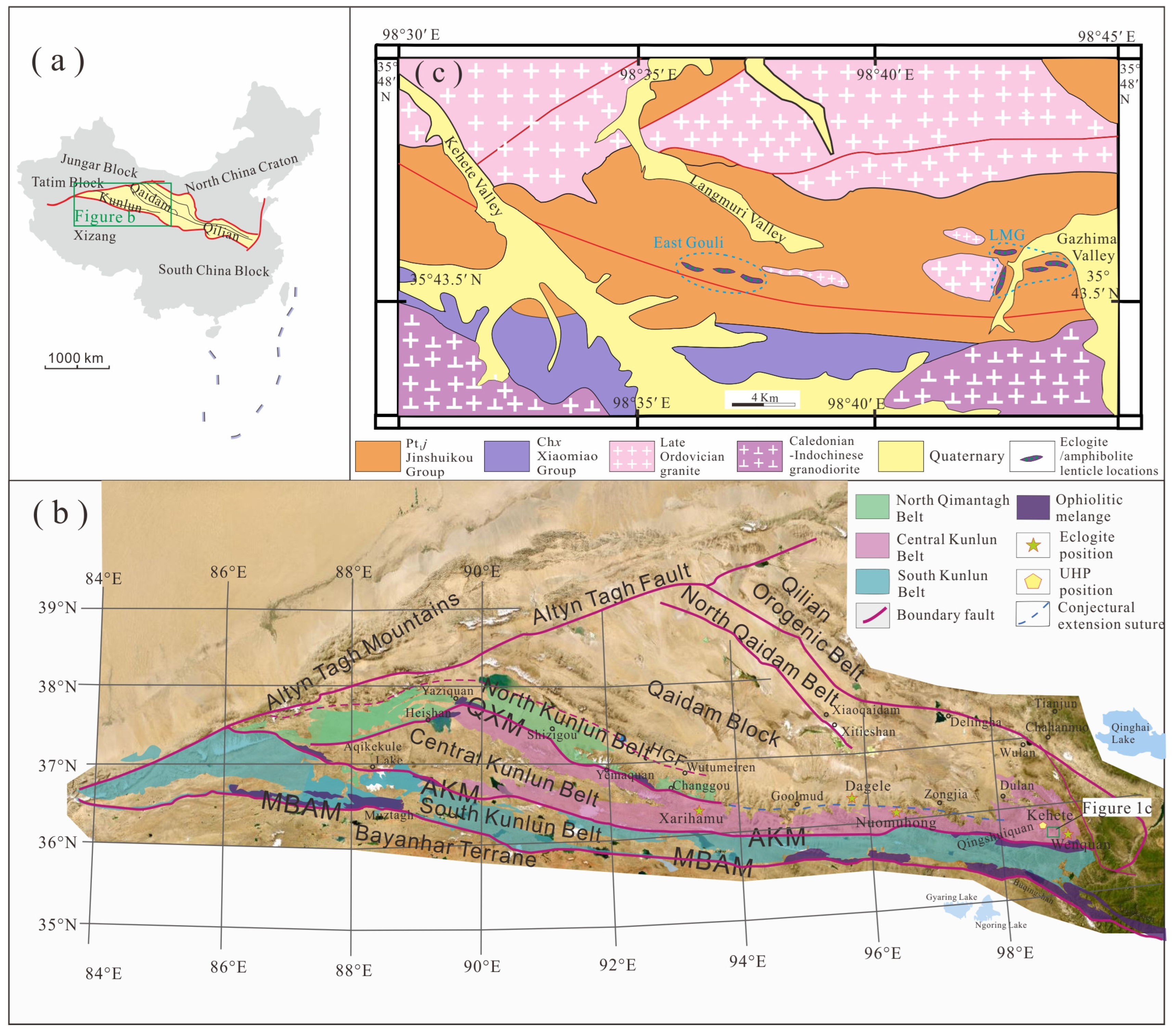
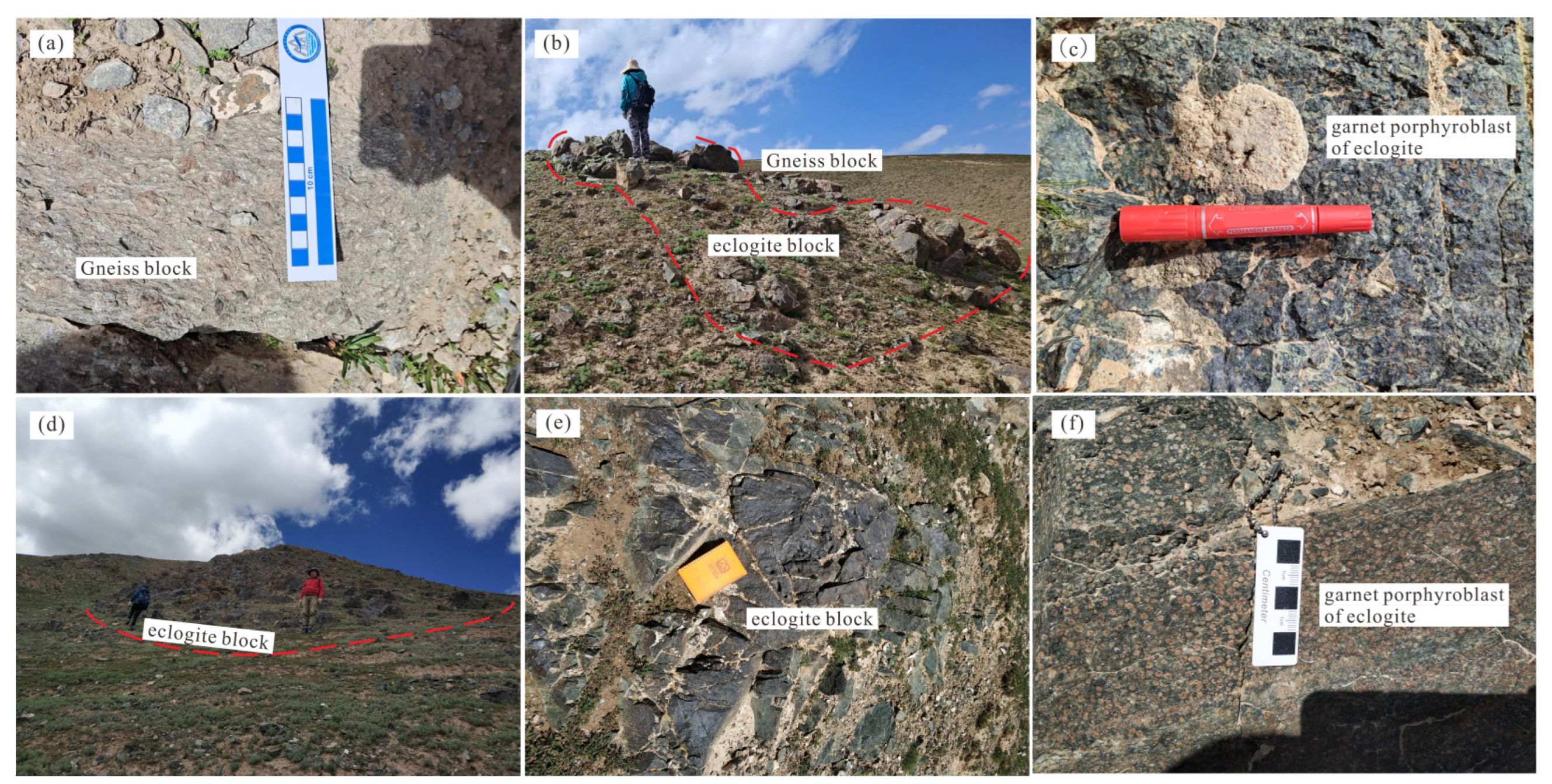
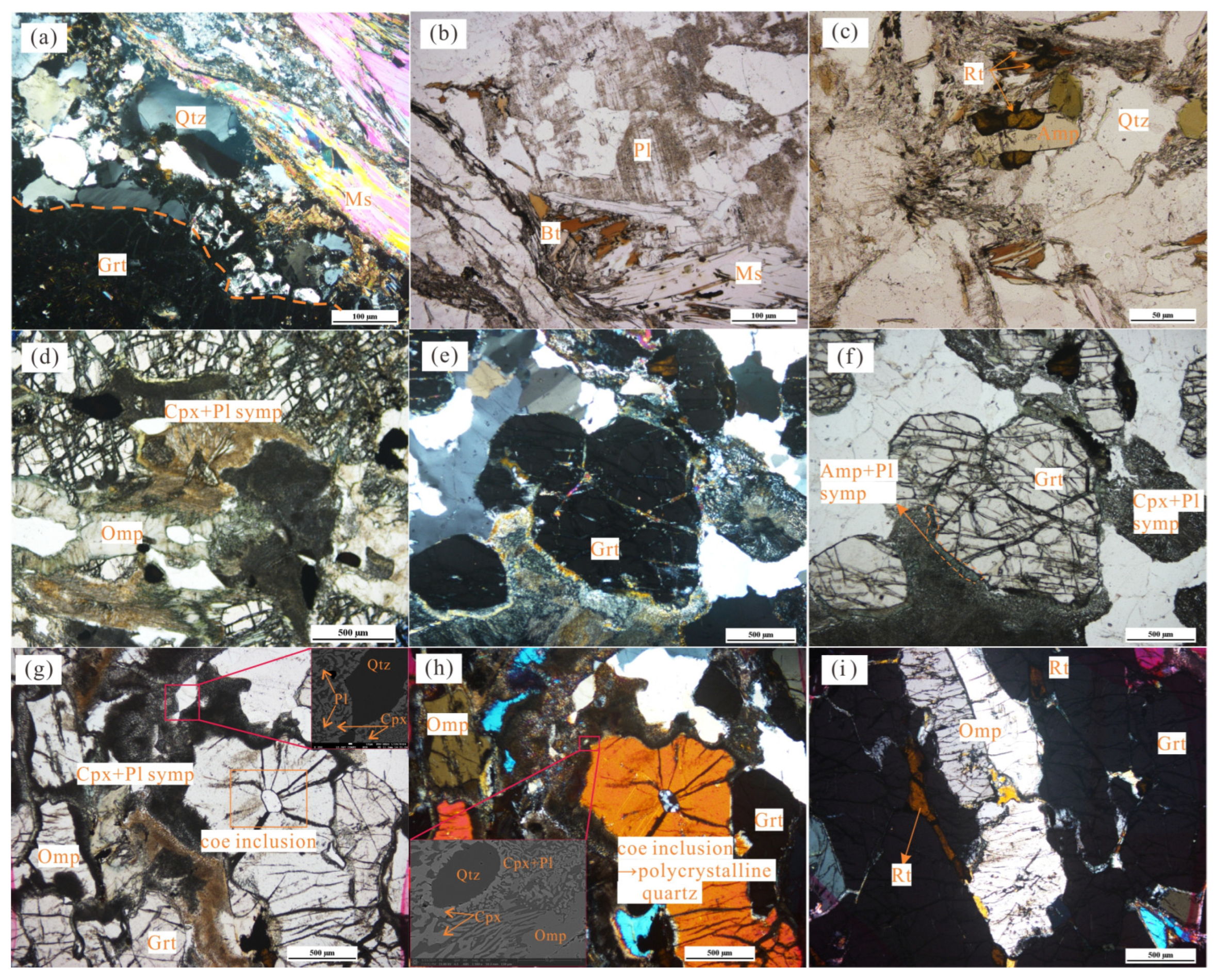

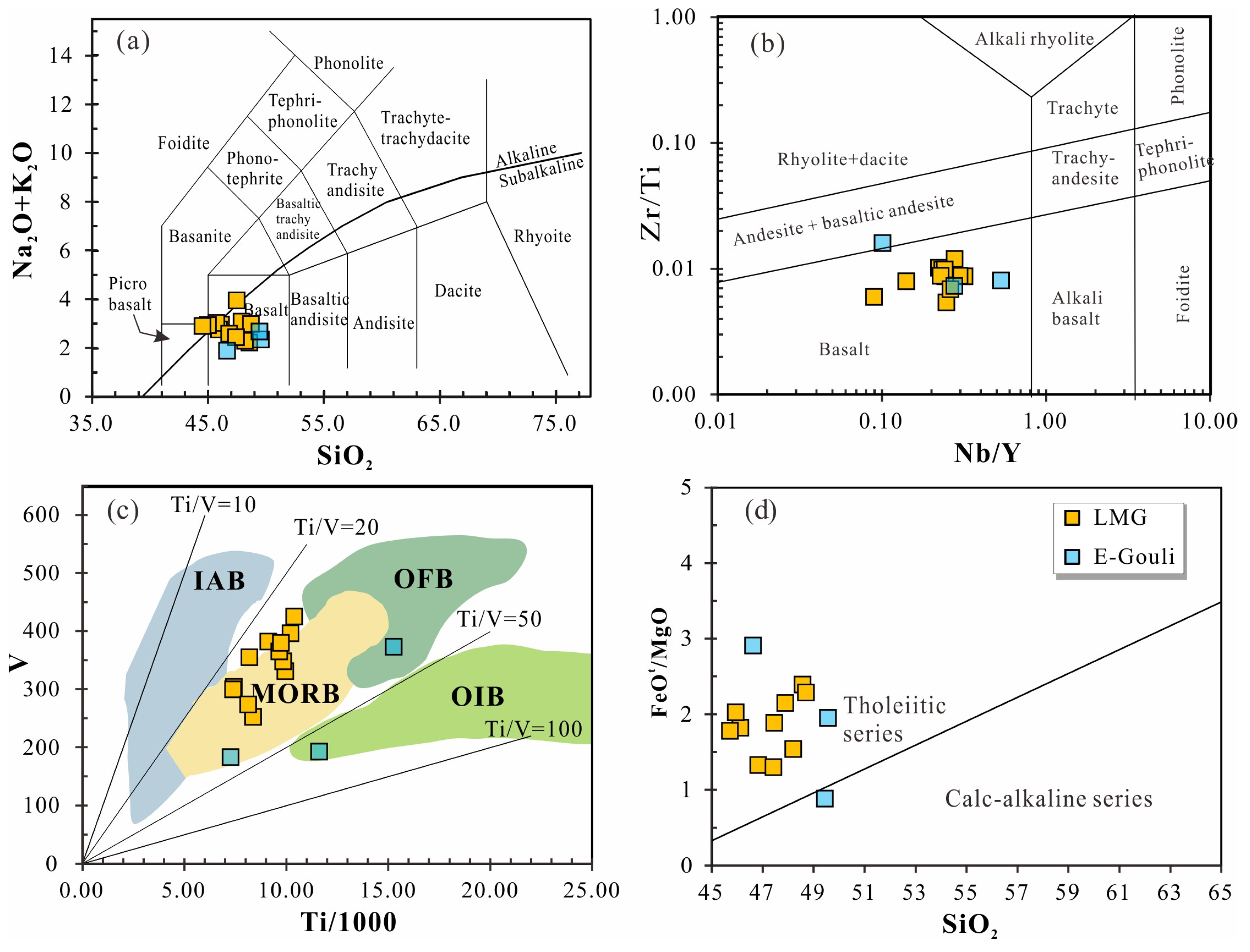
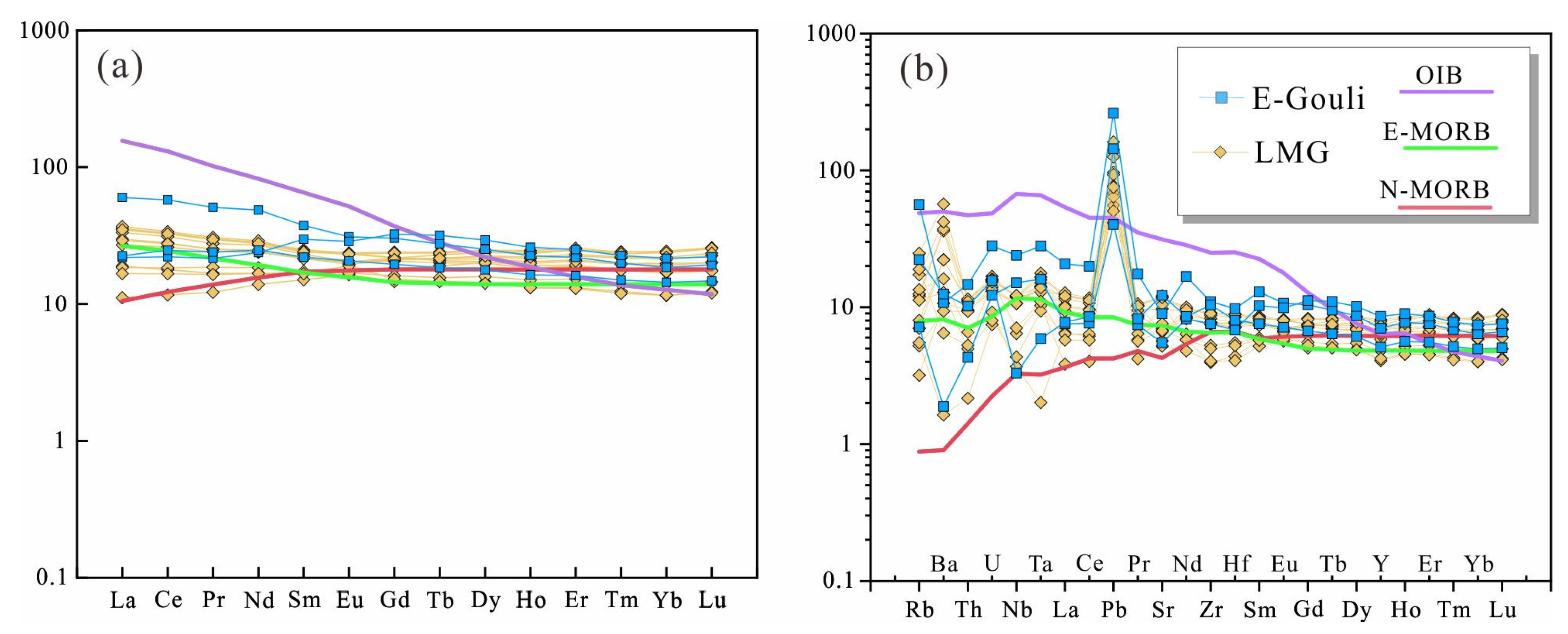
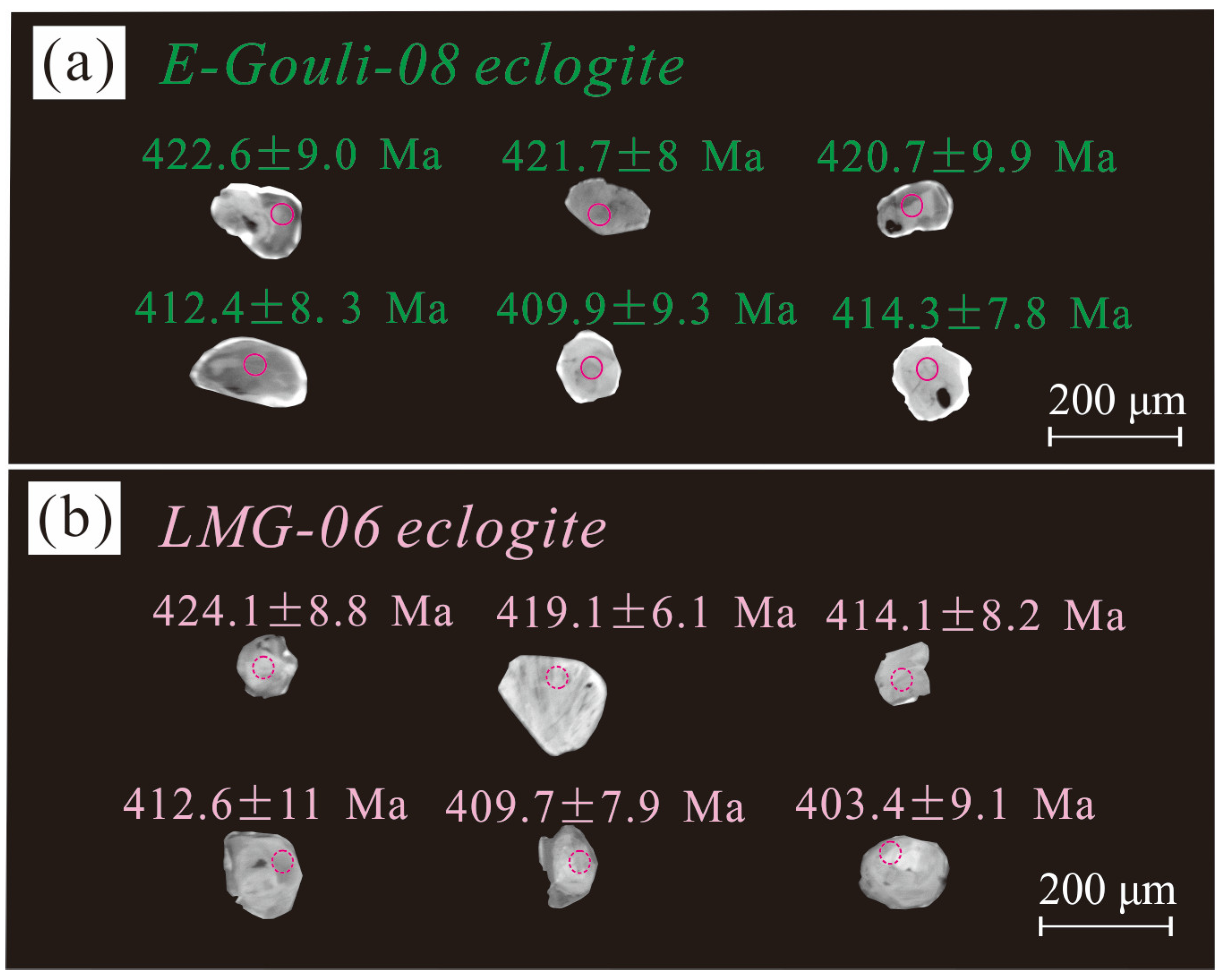

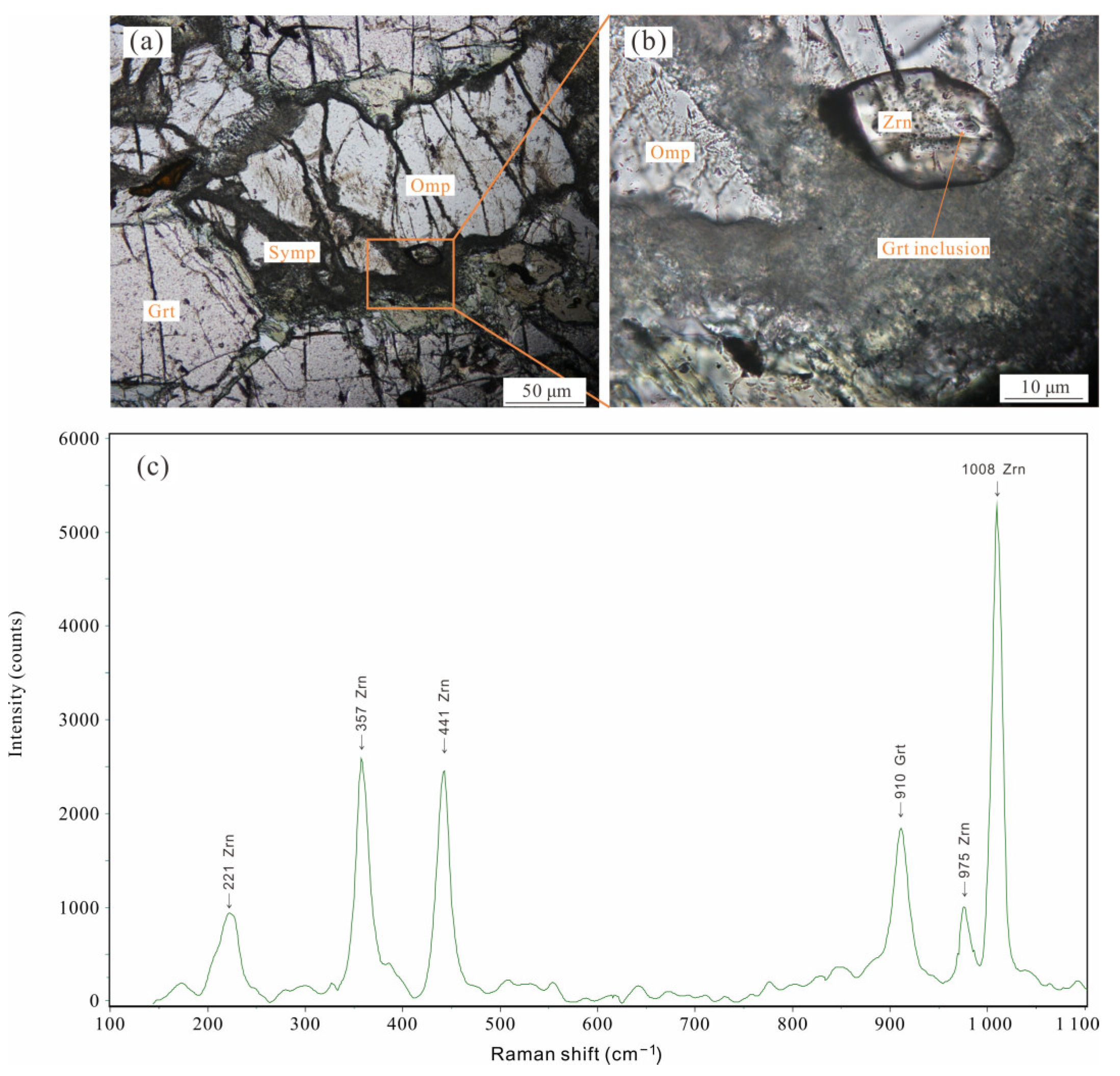
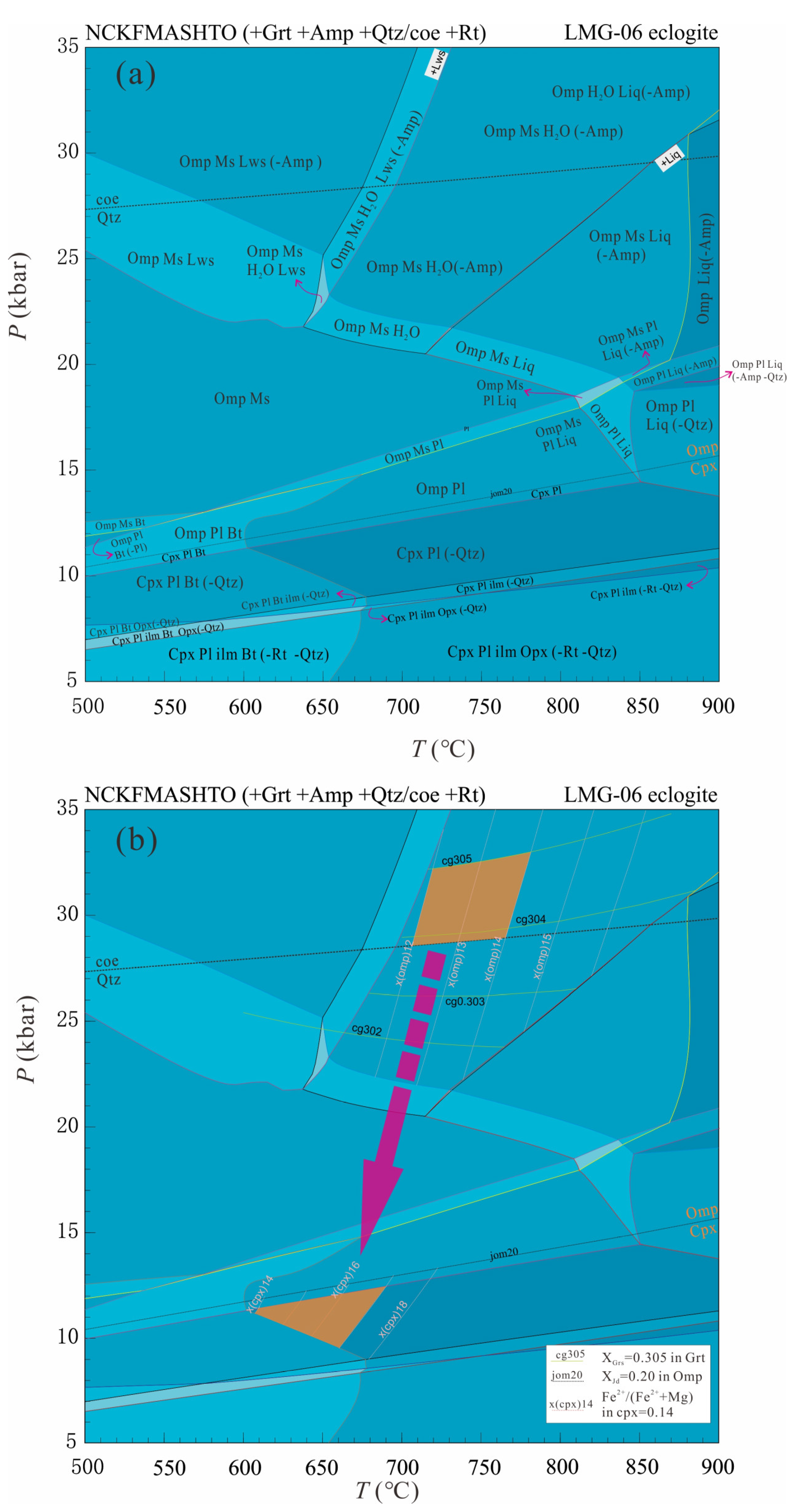
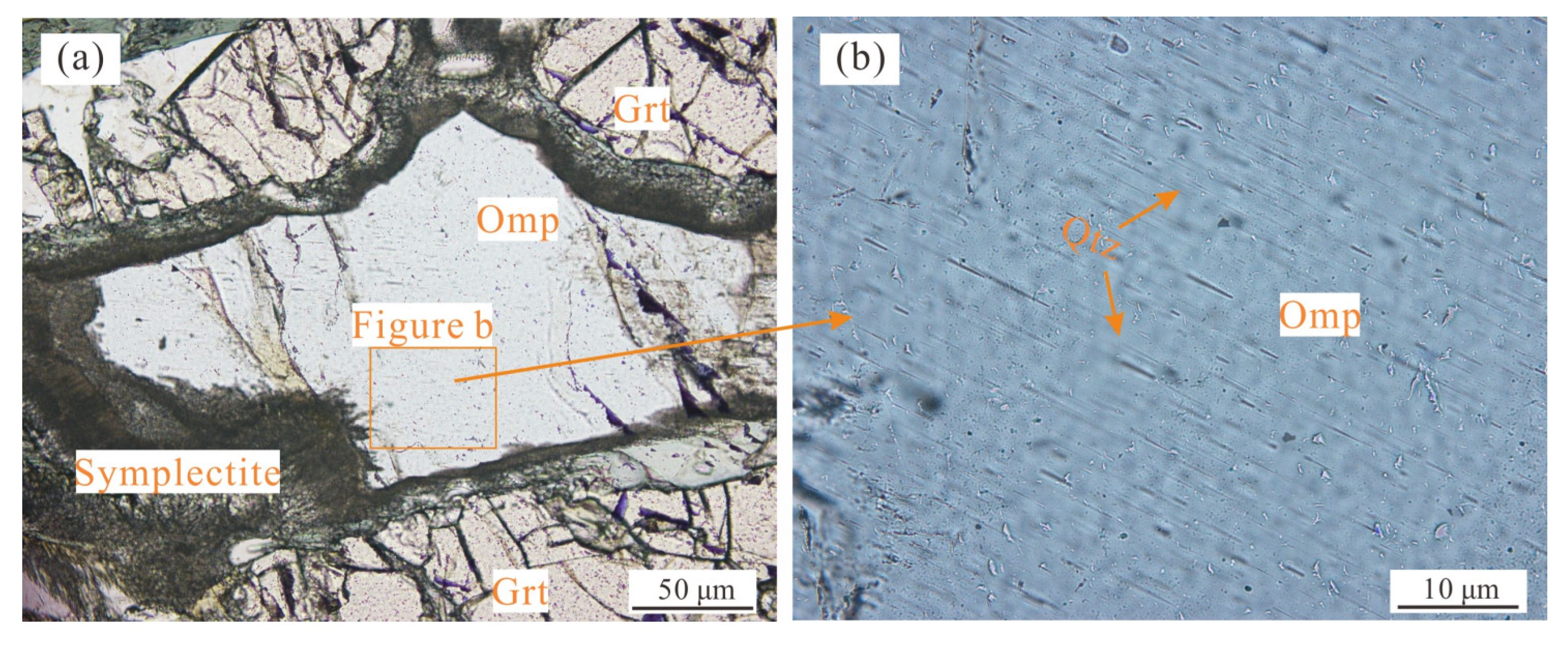

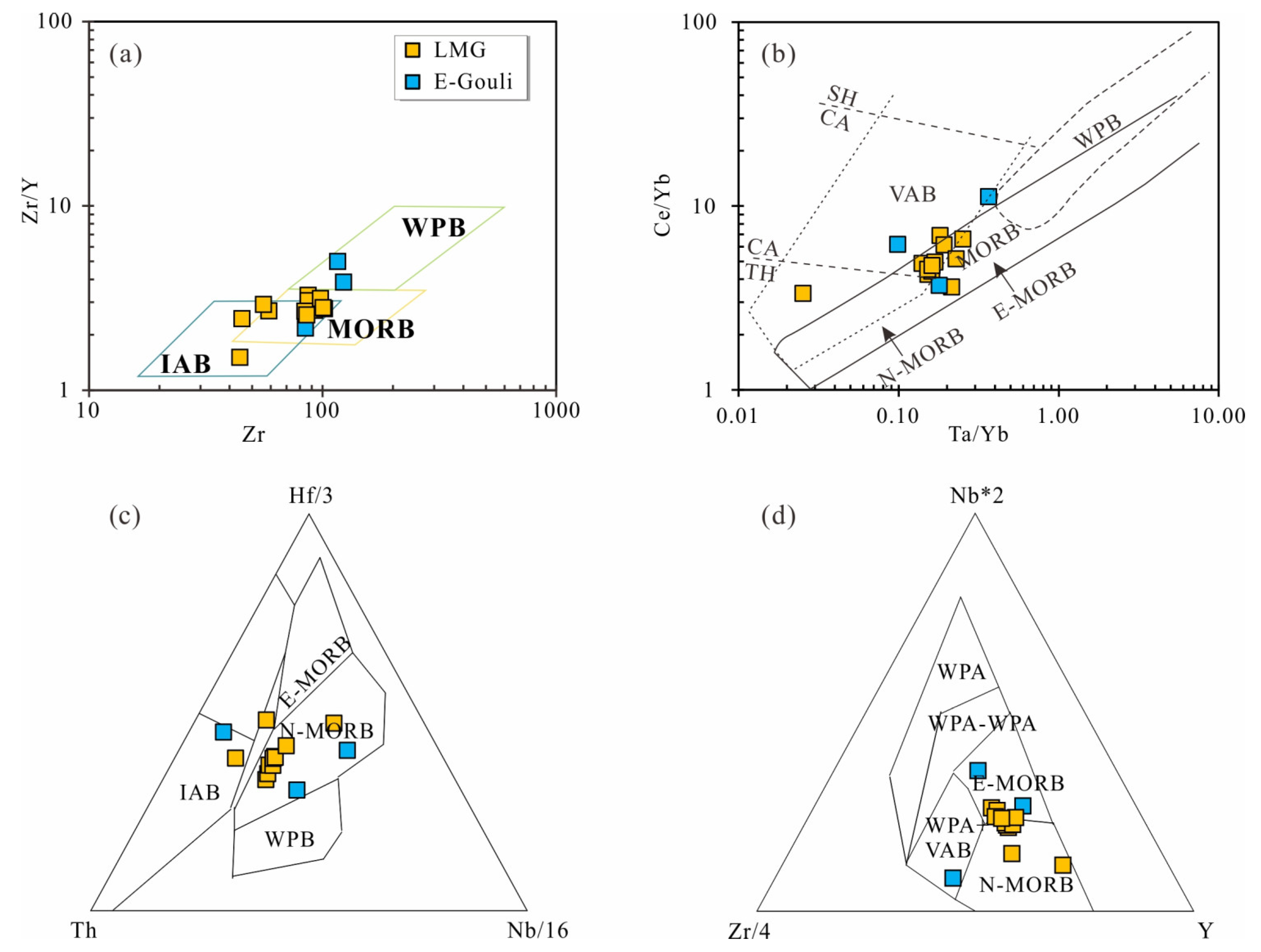

| XRF Whole-Rock Compositions (wt.%) | ||||||||||
| SiO2 | TiO2 | Al2O3 | TFe2O3 | MnO | MgO | CaO | Na2O | K2O | P2O5 | LOI |
| 46.83 | 1.40 | 16.80 | 12.60 | 0.19 | 8.55 | 10.47 | 2.49 | 0.09 | 0.09 | 0.29 |
| Normalized molar proportion used for phase equilibria modelling (mol.%) | ||||||||||
| SiO2 | TiO2 | Al2O3 | CaO | MgO | FeO | K2O | Na2O | MnO | O | H2O |
| 49.01 | 1.06 | 10.98 | 12.35 | 12.43 | 9.85 | 0.07 | 2.9 | 0.12 | 0.22 | 1.31 |
Disclaimer/Publisher’s Note: The statements, opinions and data contained in all publications are solely those of the individual author(s) and contributor(s) and not of MDPI and/or the editor(s). MDPI and/or the editor(s) disclaim responsibility for any injury to people or property resulting from any ideas, methods, instructions or products referred to in the content. |
© 2024 by the authors. Licensee MDPI, Basel, Switzerland. This article is an open access article distributed under the terms and conditions of the Creative Commons Attribution (CC BY) license (https://creativecommons.org/licenses/by/4.0/).
Share and Cite
Chang, F.; Zhang, G.; Xiong, L. The Discovery of the New UHP Eclogite from the East Kunlun, Northwestern China, and Its Tectonic Significance. Minerals 2024, 14, 582. https://doi.org/10.3390/min14060582
Chang F, Zhang G, Xiong L. The Discovery of the New UHP Eclogite from the East Kunlun, Northwestern China, and Its Tectonic Significance. Minerals. 2024; 14(6):582. https://doi.org/10.3390/min14060582
Chicago/Turabian StyleChang, Feng, Guibin Zhang, and Lu Xiong. 2024. "The Discovery of the New UHP Eclogite from the East Kunlun, Northwestern China, and Its Tectonic Significance" Minerals 14, no. 6: 582. https://doi.org/10.3390/min14060582
APA StyleChang, F., Zhang, G., & Xiong, L. (2024). The Discovery of the New UHP Eclogite from the East Kunlun, Northwestern China, and Its Tectonic Significance. Minerals, 14(6), 582. https://doi.org/10.3390/min14060582





